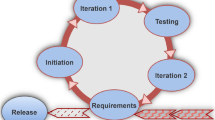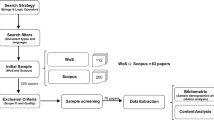Abstract
This paper presents a case study of one traditionally non-agile Information Technology (IT) services organisation in Ireland during its transition to implementing and using an agile development framework. The case study follows the experiences of using Scrum for a major IT systems conversion project in the insurance industry over the course of 9 months and 18 sprint cycles. A grounded theory approach was adopted to organically understand how productivity, effectiveness and workflow priorities emerged and were influenced by the agile approach. Secondary data sources, including the minutes of official track meetings and other stakeholder emails into the Scrum team, were analysed and categorised. A total of 460 work item requests were identified in the data, and a total of 88 work topic categories ultimately emerged from the grounded analysis. The 12 most repetitive topic categories, having demonstrated good data saturation, were subsequently selected for further analysis. The findings suggest that recurrent ad hoc requests from stakeholders into the Scrum development team significantly interrupted work on prioritised work items, making sprint objectives difficult to achieve and affecting Scrum team productivity and effectiveness overall. There was also broad evidence that powerful stakeholders tended to adhere to a traditional non-agile management philosophy, thus undermining the self-organising flexibility required by the agile approach. Stakeholders also often had no shared notion of when a work item or sprint goal was complete, thus contributing to the agile anti-patterns observed and suggesting that an agile culture had yet to emerge or instil within the traditionally non-agile organisation.




Similar content being viewed by others
References
Ahimbisibwe, A., Cavana, R. Y., & Daellenbach, U. (2015). A contingency fit model of critical success factors for software development projects: A comparison of agile and traditional plan-based methodologies. Journal of Enterprise Information Management, 28(1), 7–33.
Annosi, M. C., Magnusson, M., Martini, A., & Appio, F. P. (2016). Social conduct, learning and innovation: An abductive study of the dark side of agile software development. Creativity and Innovation Management, 25(4), 515–535.
Badampudi, D., Fricker, S. A., & Moreno, A. M. (2013). Perspectives on productivity and delays in large-scale agile projects. In 14th international conference on agile software development, Vienna, Austria, 2013 (pp. 180–194): Springer.
Baskerville, R., Pries-Heje, J., & Madsen, S. (2011). Post-agility: What follows a decade of agility? Information and Software Technology, 53(5), 543–555.
Carew, P. J., & Stapleton, L. (2014). Towards empathy: A human-centred analysis of rationality, ethics and praxis in systems development. AI & Society, 29(2), 149–166.
Cervone, H. F. (2011). Understanding agile project management methods using Scrum. OCLC Systems & Services: International Digital Library Perspectives, 27(1), 18–22.
Chandra Misra, S., Kumar, V., & Kumar, U. (2010). Identifying some critical changes required in adopting agile practices in traditional software development projects. International Journal of Quality & Reliability Management, 27(4), 451–474.
Chow, T., & Cao, D.-B. (2008). A survey study of critical success factors in agile software projects. Journal of Systems and Software, 81(6), 961–971.
Conboy, K. (2009). Agility from first principles: Reconstructing the concept of agility in information systems development. Information Systems Research, 20(3), 329–354.
Conlon, P., & Carew, P. (2005). A risk driven framework for open source information systems development. In Proceedings of the 1st international conference on open source systems, Genova, Italy, 2005 (pp. 200–203).
Cooke, J. L. (2014). Agile productivity unleashed: Proven approaches for achieving real productivity gains in any organization. Cambridgeshire: IT Governance Publishing.
Cram, W. A. (2012). Aligning organizational values in systems development projects. Management Research Review, 35(8), 709–726.
Denning, S. (2016). Agile’s ten implementation challenges. Strategy & Leadership, 44(5), 15–20.
Dikert, K., Paasivaara, M., & Lassenius, C. (2016). Challenges and success factors for large-scale agile transformations: A systematic literature review. Journal of Systems and Software, 119, 87–108.
Dingsøyr, T., Nerur, S., Balijepally, V., & Moe, N. B. (2012). A decade of agile methodologies: Towards explaining agile software development. The Journal of Systems and Software, 6(85), 1213–1221.
Dorairaj, S., & Noble, J. (2013). Agile software development with distributed teams: Agility, distribution and trust. In Agile conference (AGILE), Nashville, TN, 2013 (pp. 1–10): IEEE.
Drury-Grogan, M. L. (2014). Performance on agile teams: Relating iteration objectives and critical decisions to project management success factors. Information and Software Technology, 56(5), 506–515.
Dybå, T., & Dingsøyr, T. (2008). Empirical studies of agile software development: A systematic review. Information and Software Technology, 50(9), 833–859.
Eloranta, V.-P., Koskimies, K., & Mikkonen, T. (2016). Exploring ScrumBut—an empirical study of Scrum anti-patterns. Information and Software Technology, 74, 194–203.
Eloranta, V.-P., Koskimies, K., Mikkonen, T., & Vuorinen, J. (2013). Scrum anti-patterns—an empirical study. In 20th Asia-Pacific software engineering conference (APSEC), Bangkok, Thailand, 2013 (Vol. 1, pp. 503–510): IEEE.
Fontana, A., & Frey, J. H. (2000). The interview: From structured questions to negotiated text. In N. K. Denzin & Y. S. Lincoln (Eds.), Handbook of qualitative research (pp. 645–672). CA: Sage.
Fowler, M., & Highsmith, J. (2001). The agile manifesto. Software Development, 9(8), 28–35.
Glaser, B. G. (1978). Theoretical sensitivity: Advances in the methodology of grounded theory. Mill Valley, CA: Sociology Press.
Gregory, P., Barroca, L., Taylor, K., Salah, D., & Sharp, H. (2015). Agile challenges in practice: A thematic analysis. In 16th international conference on agile software development, Helsinki, Finland, 2015 (pp. 64–80): Springer.
Hoda, R., Noble, J., & Marshall, S. (2011). The impact of inadequate customer collaboration on self-organizing Agile teams. Information and Software Technology, 53(5), 521–534.
Hoda, R., Noble, J., & Marshall, S. (2012). Developing a grounded theory to explain the practices of self-organizing Agile teams. Empirical Software Engineering, 17(6), 609–639.
Hummel, M. (2014). State-of-the-art: A systematic literature review on agile information systems development. In 47th Hawaii international conference on system sciences (HICSS), Waikoloa, HI, 2014 (pp. 4712–4721): IEEE.
Hummel, M., Rosenkranz, C., & Holten, R. (2013). The role of communication in agile systems development. Business & Information Systems Engineering, 5(5), 343–355.
Iivari, J., & Iivari, N. (2011). The relationship between organizational culture and the deployment of agile methods. Information and Software Technology, 53(5), 509–520.
Inayat, I., Salim, S. S., Marczak, S., Daneva, M., & Shamshirband, S. (2015). A systematic literature review on agile requirements engineering practices and challenges. Computers in Human Behavior, 51, 915–929.
Kautz, K. (2011). Investigating the design process: participatory design in agile software development. Information Technology & People, 24(3), 217–235.
Loforte Ribeiro, F., & Timóteo Fernandes, M. (2010). Exploring agile methods in construction small and medium enterprises: A case study. Journal of Enterprise Information Management, 23(2), 161–180.
López-Martínez, J., Juárez-Ramírez, R., Huertas, C., Jiménez, S., & Guerra-García, C. (2016). Problems in the adoption of Agile-Scrum methodologies: A systematic literature review. In 4th international conference in software engineering research and innovation (CONISOFT), Puebla, Mexico, 2016 (pp. 141–148): IEEE.
Murphy, B., Bird, C., Zimmermann, T., Williams, L., Nagappan, N., & Begel, A. (2013). Have agile techniques been the silver bullet for software development at microsoft? In ACM/IEEE 7th international symposium on empirical software engineering and measurement, Baltimore, MD, 2013 (pp. 75–84): IEEE.
Schwaber, K., & Sutherland, J. (2012). Software in 30 days: How agile managers beat the odds, delight their customers, and leave competitors in the dust. New York, NY: Wiley.
Scrum Alliance (2015). The 2015 State of Scrum report. Scrum Alliance.
Shastri, Y., Hoda, R., & Amor, R. (2017). Understanding the roles of the manager in agile project management. In Proceedings of the 10th innovations in software engineering conference, Jaipur, India, 2017 (pp. 45–55): ACM.
Sommerville, I. (2015). Software engineering (10th ed.). Boston, MA: Addison-Wesley.
Stankovic, D., Nikolic, V., Djordjevic, M., & Cao, D.-B. (2013). A survey study of critical success factors in agile software projects in former Yugoslavia IT companies. Journal of Systems and Software, 86(6), 1663–1678.
Stoica, M., Mircea, M., & Ghilic-Micu, B. (2013). Software development: Agile versus traditional. Informatica Economica, 17(4), 64.
Sushil, (2017). Flexible systems management as an iterative process. Global Journal of Flexible Systems Management, 18(2), 87–88.
Taylor, K. J. (2016). Adopting Agile software development: The project manager experience. Information Technology & People, 29(4), 670–687.
Walsham, G. (1993). Interpreting information systems in organizations. Chichester: Wiley.
Yadav, V. (2016). A flexible management approach for globally distributed software projects. Global Journal of Flexible Systems Management, 17(1), 29–40.
Yin, R. K. (2013). Validity and generalization in future case study evaluations. Evaluation, 19(3), 321–332.
Author information
Authors and Affiliations
Corresponding author
Rights and permissions
About this article
Cite this article
Carew, P.J., Glynn, D. Anti-patterns in Agile Adoption: A Grounded Theory Case Study of One Irish IT Organisation. Glob J Flex Syst Manag 18, 275–289 (2017). https://doi.org/10.1007/s40171-017-0162-8
Received:
Accepted:
Published:
Issue Date:
DOI: https://doi.org/10.1007/s40171-017-0162-8




